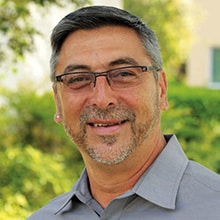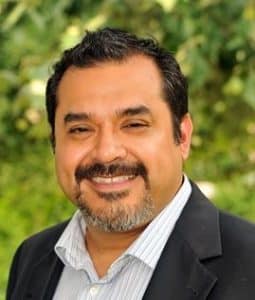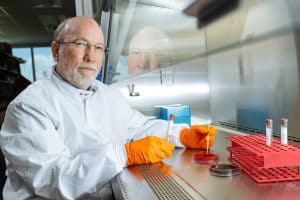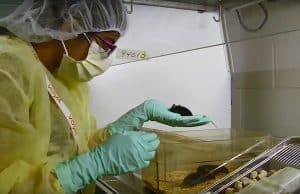Watching a troop of baboons run and roam and forage and play is a breathtaking sight. They are some of the world’s largest monkeys — fascinating animals with great strength and curiosity. Baboons are ground dwellers that often live on the savanna or in open woodlands in Africa.
The baboons at Texas Biomed aren’t from another country. They’re South Texan — born and bred — part of a unique pedigreed colony at the Southwest National Primate Research Center going back seven generations. They are a valuable biomedical research asset.
More than a thousand baboons live at Texas Biomed. More than a hundred young males live in a six-acre corral where the animal care staff makes sure they get to behave as naturally as possible.
For more information about animals in research and recent events, please see our frequently asked questions page.
“Just because they are animals used for biomedical research, it doesn’t lessen that dedication and that commitment to their welfare and care,” said John Bernal, DVM, Associate Director of Veterinary Resources and Research Support.

Dr. Bernal oversees the treatment of the more than 2,000 animals that are part in the quest for new cures and treatments.
“We have a very clear and firm responsibility to these animals to treat them with dignity and optimal care,” he explained.
Texas Biomed animal operating rooms look like ORs you might find in a community hospital for people, complete with anesthesia machines and blood pressure monitors. Fluoroscopy machines can track the injection of dye for sophisticated imaging.
Just as the animals’ medical needs are met at a high standard, the primates’ housing is also attended to with care. Cages are cleaned daily. Caregivers bring special enrichment food and interact with the animals.
In addition to baboons, Texas Biomed has 900 macaques, an important animal model that helps scientists investigate diseases like Ebola and HIV.
Scientist Ricardo Carrion, Jr., Ph.D., has been working with research animals for the past 15 years. He investigates vaccines and treatments for diseases for which there is no cure. He considers the role of animals crucial to future breakthroughs in bioscience.

“I believe that animal models provide us insight into diseases that we would not be able to understand otherwise,” Dr. Carrion stated.
Dr. Carrion and his team work in the Biosafety Level 4 lab. They suit up in protective gear to protect themselves against some of the world’s deadliest pathogens. Without animals that can mimic human disease, Dr. Carrion says progress would be slowed to a glacial pace.
“We all care for animals,” he said. “They’re a valuable resource. We depend on them for us having these scientific breakthroughs. So we all work together to make sure that we use the smallest number of animals necessary and we use the right model.”
The right model for Hepatitis C – a disease that affects 180 million people — was the chimpanzee. One Texas Biomed researcher devoted most of his career to pinpointing this disease, discovering how it impacted the body, and along with many other scientists, helped develop a cure on the market today. A single pill a day for 12 weeks can wipe out this previously intractable health issue.
“There were no small animal models,” said Scientist Robert Lanford, Ph.D. “And finally the chimpanzee was found to be the only animal that could be infected. We don’t use chimpanzees for research any longer. But we must appreciate that they were critical for every part of the process in developing this cure.”
“Our goal is to give people longer, happier lives,” Lanford continued. “The immune response…how the brain works. We can start that in small animals. But when we get to the point where we’re going to move forward into humans, we want to know that it’s going to work and it’s going to be safe. And today we still need research in monkeys.”
Scientists follow federal guidelines in animal research, with oversight from several agencies. A committee that includes not only scientists, but also community members, evaluates how the research is conducted and reviews all of the protocols before any studies can move forward.

New World animals called marmosets are the smallest monkeys on the Texas Biomed campus. Miniature, but mighty. The colony of 300 of these fast-moving monkey about the size of a guinea pig with a tail are important models in aging studies. They often have twins or triplets, making them a good model for studies involving maternal-fetal health issues, like the emerging Zika virus.
The scientific work in these larger mammals is built on the work first performed in smaller mammals like mice at UT Health San Antonio.
Hye Young Lee, Ph.D., is researching autism in the Department of Cellular and Integrative Physiology. She explains small animal models allow scientists to study the practicality of treatments before using more complex animals.
“We give the greatest care to our animals at UT Health San Antonio to ensure the rights they possess in nature,” Lee said. “We believe that healthy animals provide the best results in research. So we proudly uphold standards of human treatments. To advance healthcare, we need animal models. They allow us to safely test treatments and verify their functionality before we treat people.”
Dr. Lee’s promising work with genetically engineered mice is shedding light on possible interventions for people with autism. She said she couldn’t pursue any breakthroughs without living, breathing subjects.

“Computer models simply lack sufficient information or data to predict what occurs on the frontier of science,” Lee explained.
In Dr. Carrion’s mind, good science and good animal care are inseparable.
“When you have animals that are healthy, that are getting good care, we know that the results of the experiment can be trusted,” he stated.
For many scientists and veterinarians in the biomedical field, animals are the unsung heroes of biomedical research.
“I have a real tender spot,” Dr. Lanford said. “I mean, I have had dogs and cats and animals at home all my life. When I come here, I bring that same love for animals. And that’s the reason I appreciate the loving care I see being given to these animals by the animal care staff, the veterinarians and the technicians. They take great care of these animals.”